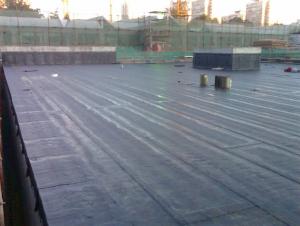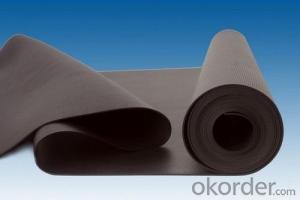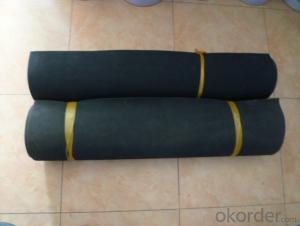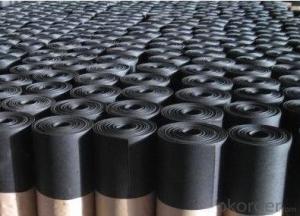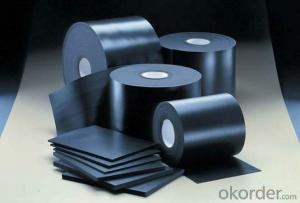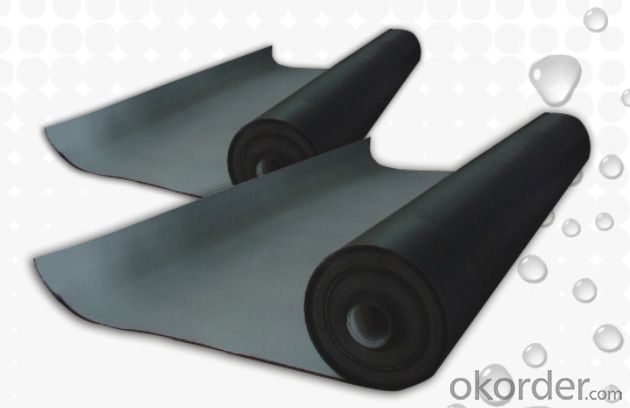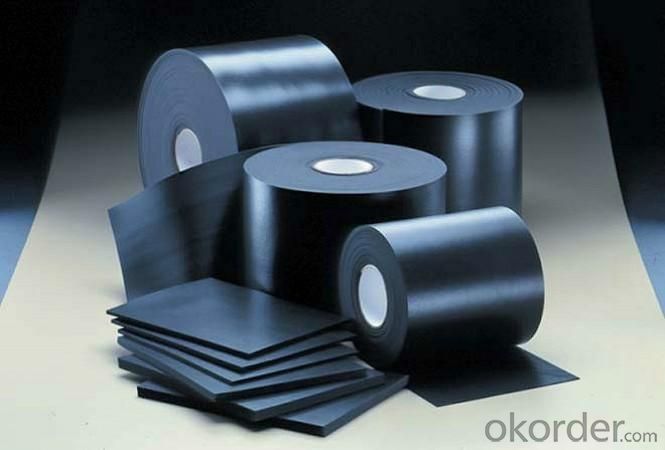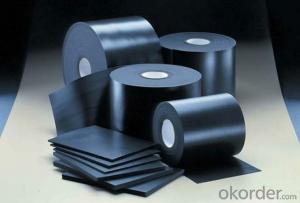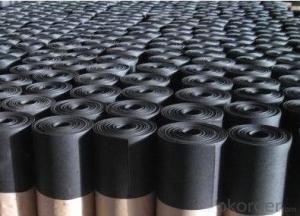EPDM Coiled Rubber Waterproof Membrane for Roofs/Ponds/Basement
- Loading Port:
- Shanghai
- Payment Terms:
- TT or LC
- Min Order Qty:
- 10000 m²
- Supply Capability:
- 1200000 m²/month
OKorder Service Pledge
OKorder Financial Service
You Might Also Like
EPDM Coiled Rubber Waterproof Membrane for Roofs/Ponds/Basement
Description Of EPDM Coiled Rubber Waterproof Membrane for Roofs/Ponds/Basement:
1. EPDM waterproof membrane is made from ternary ethylene-propylene rubber, which is for waterproofing of exposed and non-exposed applications.
2. EPDM waterproof membrane production adopts the world-advanced equipment of cold feeding extrusion and continuous vulcanization technology.
3. EPDM waterproof membrane is of high elasticity among high polymer waterproof materials and becomes a world-popular waterproofing material.
Main Features of EPDM Coiled Rubber Waterproof Membrane for Roofs/Ponds/Basement:
1. Excellent physical and mechanical performance
2. High tearing resistance
3. Good deformation adaptability
4. High puncture resistance
5. High aging resistance
6. UV resistance
Specifications of EPDM Coiled Rubber Waterproof Membrane for Roofs/Ponds/Basement:
| Material | EPDM Rubber |
| Size | 1.2m (width)*20m (length) or customized, weldable type 2.05m or 4m width |
| Thick | 1.2mm, 1.5mm, 2.0mm |
| Type | Vulcanized & Weldable |
| Pattern | Non-reinforced (homogeneous) |
| Certificate | ISO9001/14001 |
Applications of EPDM Coiled Rubber Waterproof Membrane for Roofs/Ponds/Basement:
1.Roofs, Basement, Toilets
2. Industrial and civil building waterproofing
3. Geosynthetic liner for swimming pool, channels, irrigation system
4. Especially suitable for projects with high requirements in durability, anti-corrosion and deformation.
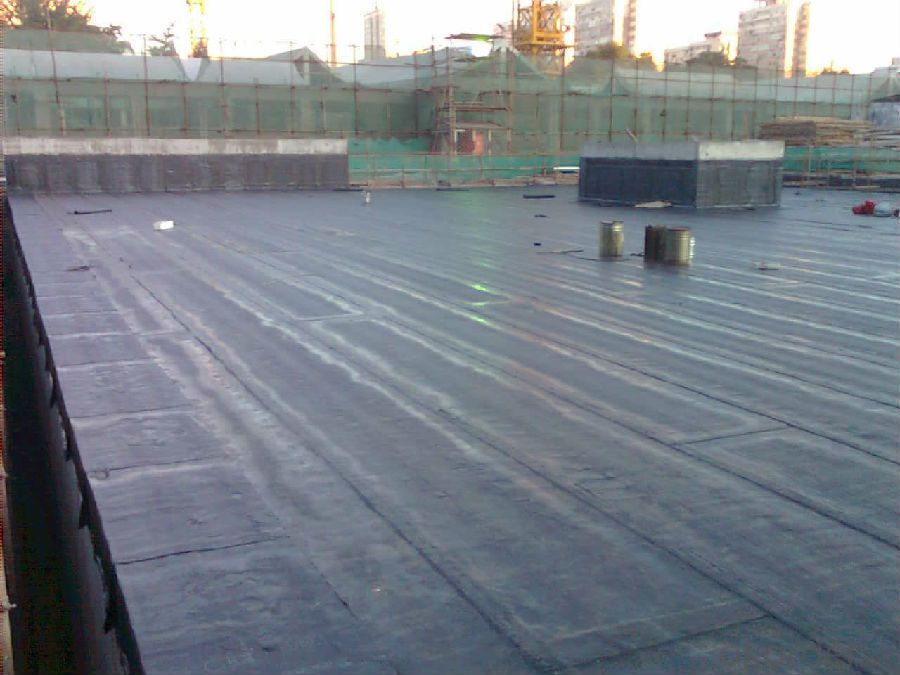
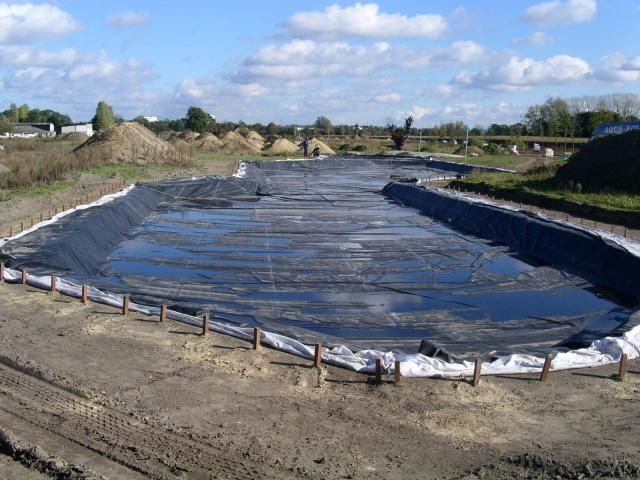

IMages of EPDM Coiled Rubber Waterproof Membrane for Roofs/Ponds/Basement:
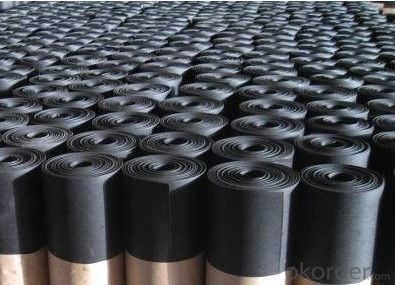
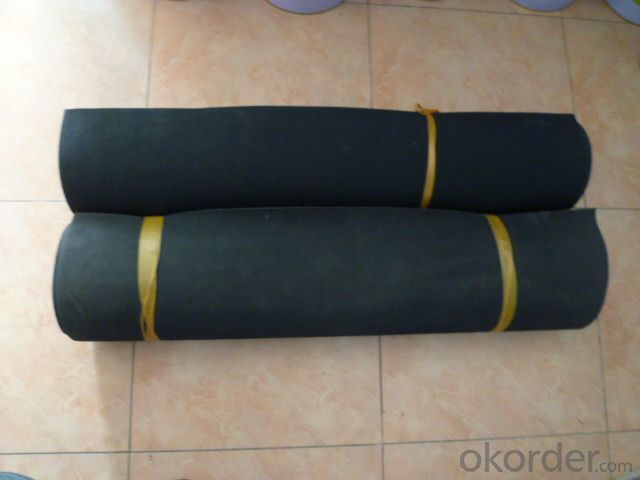


FAQ of EPDM Coiled Rubber Waterproof Membrane for Roofs/Ponds/Basement:
1. What are we supplying?
We are specialized in producing Colorful Asphalt Roof Shingle, SBS/APP modified bitumen waterproof membrane, Self adhesive bitumen waterproof membrane, PVC waterproofing membrane, EPDM rubber roofing membrane, Single Component Polyurethane Waterproof Coating, and Spray Polyurea Waterproof Coating
.
2. How Many years experience do we have?
We have been exported to more than 20 countries in the past 15 years.
3. How long do we usually reply your request?
We always reply our customer within 24 hours.
- Q: Can waterproofing membranes be painted over?
- Painting over a waterproofing membrane is indeed possible. Nevertheless, it is crucial to verify the compatibility between the paint and the membrane material. It is advisable to refer to the manufacturer's guidelines or seek expert advice in order to guarantee the paint adheres well and lasts long. Furthermore, prior to applying the paint, the surface must be clean and dry to achieve optimal outcomes. All in all, painting over a waterproofing membrane can improve its aesthetic and offer extra safeguard against UV rays and other environmental elements.
- Q: What is the difference between a liquid and sheet-type waterproofing membrane?
- A liquid waterproofing membrane is a type of coating that is applied in liquid form and then dries to form a protective layer. It is typically applied using a brush, roller, or spray. On the other hand, a sheet-type waterproofing membrane is a pre-manufactured material that is typically made of rubber, PVC, or bitumen. It comes in large rolls or sheets and is usually installed by overlapping the sheets and adhering them to the surface using adhesives or heat. In terms of installation, liquid waterproofing membranes are generally easier to apply as they can be easily molded and shaped to fit various surfaces and contours. They can also be applied to both horizontal and vertical surfaces without the need for seams or joints. Sheet-type membranes, on the other hand, require careful measurements and cutting to fit the surface properly. They also require more labor and time to install due to the need for overlapping and sealing the joints. In terms of flexibility, liquid membranes tend to have better flexibility as they can conform to irregular surfaces and movements without cracking or tearing. Sheet-type membranes, although flexible to some extent, may not be able to adapt as well to surface movements or changes in temperature. Another difference is in terms of durability and lifespan. Sheet-type membranes are typically thicker and more robust, providing a longer lifespan and better resistance to punctures and mechanical damage. Liquid membranes, although they can provide effective waterproofing, may not be as durable or long-lasting, especially in high-traffic areas or areas prone to damage. In terms of cost, liquid waterproofing membranes are generally more cost-effective compared to sheet-type membranes. They require less labor and materials for installation, making them a more budget-friendly option. However, it's important to consider the specific requirements and conditions of the project to determine the most suitable type of waterproofing membrane. Overall, the choice between a liquid and sheet-type waterproofing membrane depends on various factors such as the nature of the project, the surface conditions, the level of flexibility and durability required, and the budget constraints.
- Q: SBs waterproof cold sticky how to do?
- 5, protective layer construction. In order to shield or reflect the sun's radiation, to extend the life of the waterproof layer of the membrane, in the waterproof layer is completed and checked after passing, should be coated on the surface of the waterproof layer of adhesive, side of the expansion of the expansion of silica powder protective layer, or uniform Brush the silver or green paint as a protective layer.
- Q: Can a waterproofing membrane be used for walkways or pedestrian bridges?
- Yes, a waterproofing membrane can be used for walkways or pedestrian bridges. Waterproofing membranes are designed to create a barrier that prevents water from seeping into the structure and causing damage. By applying a waterproofing membrane to the surface of a walkway or pedestrian bridge, it can protect the underlying structure from water infiltration, thus increasing its durability and lifespan. This is especially important in areas prone to heavy rainfall or where the walkway or bridge is exposed to water sources such as rivers or lakes. Additionally, waterproofing membranes can also provide additional benefits such as improving slip resistance and protecting against chemicals or pollutants.
- Q: Are waterproofing membranes suitable for historical buildings?
- Yes, waterproofing membranes can be suitable for historical buildings. These membranes provide an effective solution for preventing water penetration and damage to the structure, helping to preserve the integrity and longevity of the building. However, it is essential to consider the specific requirements and characteristics of the historical building and select an appropriate membrane that is compatible with its materials and architectural features. Additionally, any waterproofing work should be done with sensitivity and care to ensure it does not compromise the historical value or aesthetics of the building.
- Q: Can a waterproofing membrane be used on tunnels with security systems?
- Indeed, tunnels with security systems can utilize a waterproofing membrane. It is strongly advised to employ a waterproofing membrane in tunnels, particularly those equipped with security systems, to safeguard the infrastructure and valuable equipment from water harm. Waterproofing membranes are specifically crafted to impede water infiltration, furnishing a protective shield against water leakage and potential complications stemming from moisture, such as corrosion, mold propagation, and structural degradation. By implementing a waterproofing membrane in tunnels featuring security systems, the integrity of the tunnel structure and the efficacy of the security systems can be upheld, guaranteeing the facility's safety and security.
- Q: Does a waterproofing membrane require any curing time?
- Yes, a waterproofing membrane typically requires a curing time. The curing time allows the membrane to fully bond and form a tight seal, ensuring maximum effectiveness in preventing water penetration. The specific duration of curing time may vary depending on the type of membrane and manufacturer's instructions.
- Q: What is BSB waterproofing membrane
- Scope of application: 1. Polyester Felt-based elastomer modified asphalt waterproofing membrane for industrial and civil construction of the roof and underground waterproofing works. 2. Glass fiber reinforced polyester mattress base coil is suitable for mechanical fixed single layer waterproof, but through the wind load test. 3. Fiberglass mattresses are suitable for structural roofs and underground waterproofing works; 4. Exposure to the use of the upper surface of the insulating material for the opaque mineral pellets of the waterproofing membrane. 5. Underground engineering waterproofing should be used surface insulation material for the fine sand of the waterproofing membrane.
- Q: Can a waterproofing membrane be used in residential construction?
- Residential construction can indeed utilize a waterproofing membrane. These membranes find common usage in different parts of a residential property, such as roofs, basements, bathrooms, and foundations. Their purpose is to prevent water from penetrating and causing damage due to moisture. By opting for a waterproofing membrane, homeowners can ensure that their property remains dry and free from water leaks. This is crucial because such leaks can result in mold growth, structural deterioration, and other costly problems. The market offers a variety of waterproofing membranes, such as sheet membranes, liquid membranes, and self-adhering membranes, each with its own advantages and suitability for specific applications. Consulting with a professional contractor or architect can assist in determining the most suitable waterproofing membrane for a particular residential construction project.
- Q: Are waterproofing membranes resistant to ponding water?
- Waterproofing membranes, in general, have a resistance to ponding water. Their purpose is to form a barrier that stops water from seeping through and causing harm to the structure beneath. This encompasses stagnant or accumulated water that may be present on the surface. Nonetheless, it should be noted that the efficacy of waterproofing membranes can differ based on the particular product and installation method utilized. It is advisable to seek guidance from an expert to guarantee the appropriate membrane is chosen and correctly installed to achieve the desired level of protection against ponding water.
Send your message to us
EPDM Coiled Rubber Waterproof Membrane for Roofs/Ponds/Basement
- Loading Port:
- Shanghai
- Payment Terms:
- TT or LC
- Min Order Qty:
- 10000 m²
- Supply Capability:
- 1200000 m²/month
OKorder Service Pledge
OKorder Financial Service
Similar products
Hot products
Hot Searches
Related keywords

